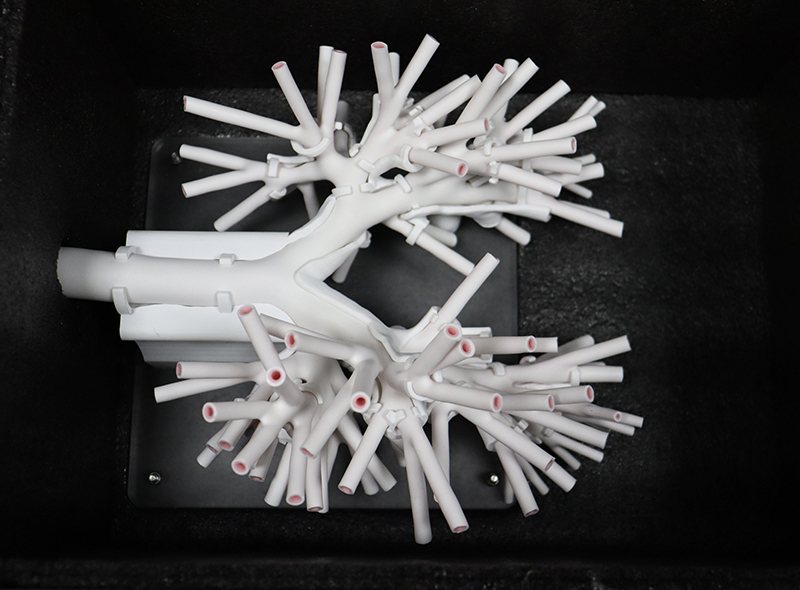Superconducting visual bronchoscopy is suitable for the observation of lobar, segmental and subsegmental bronchial lesions, biopsy sampling, bacteriological and cytological examination, photography, teaching and dynamic recording with TV system. The superconducting visual bronchoscope interventional technique is accompanied by biopsy sampling deconstruction, which can help to detect early lesions and carry out internal surgery such as polyp removal. It is a good precision instrument for bronchial and lung disease research and postoperative examination. Superconducting visual bronchoscopy has been widely used in clinic since its invention. In addition to making great progress in the diagnosis of respiratory diseases, it has also been widely used in treatment, which is described below.
The role of superconducting visual bronchoscopy interventional technique:
Extract foreign body
Commonly used are OlympusBF-P30 and P40 and portable LF-GP/TP/DP, with an outer diameter of 4.8 ~ 4.9mm, which is a superconducting visual bronchoscopy intervention technology with a smaller tube diameter in adult superconducting visual bronchoscopy intervention technology, and can also be used for pediatric patients older than 6 months, and the age of less than 6 months. The above types of superconducting visual bronchoscopic intervention technology are difficult to insert and pass through the trachea, the superconducting visual bronchoscopic intervention technology also includes PENTAXFB-15P, FB-15BS (the latter is portable superconducting visual bronchoscopic intervention technology), and optional PENTAXFB-10P, and OlympusBF-3c30. They have an outer diameter of 3.5 mm and have biopsy holes, which can be used for the examination and removal of foreign bodies in newborns.
Due to the wide variety of foreign bodies, some metal, some plants, and some animal bones, when picking, choose the appropriate foreign body pliers (such as alligator pliers, rat bite pliers, curette or pliers with metal nets, etc.). When the condition is critical, especially for children under 7 years of age, it should be carried out under general anesthesia in the operating room, and SaO2 monitoring can be done. When a metal foreign body, such as a pin falls below the segmental bronchus or subsegmental bronchus, it should be removed under X-ray or TV guidance. During surgery, the procedure should be performed carefully and quickly to prevent bleeding, mediastinal emphysema, traumatic pneumothorax, asphyxia, and cardiac arrest. Postoperative observation for secondary respiratory tract and lung infection or bleeding, children should observe whether the airway is smooth, due to the operation process can cause trachea, bronchial mucosa damage bleeding, inflammatory secretions exudate, etc., to often aspirate phlegm and monitor with blood oxygen meter, to prevent excessive tracheal secretions or vocal cord edema caused by asphyxia.

Desecretion
Chronic expiratory failure patients with respiratory tract, lung infection is not controlled, due to a large amount of secretions blocking the airway aggravate the condition.
Superconducting visual bronchoscopy intervention technology, coupled with the patient's cough and weakness, suction from the nose or mouth can not achieve the purpose of complete removal of secretions, then the superconducting visual bronchoscopy intervention technology should be used to clean the airway secretions under direct vision.
In patients with respiratory failure caused by various reasons, after artificial ventilation with tracheal intubation, due to insufficient humidification, airway dryness, airway secretions, poor drainage blocking the airway, increasing airway resistance, and poor artificial ventilation effect, it is necessary to periodically use superconducting visual bronchoscopy to aspirate sputum and strengthen airway humidification management.
After pulmonary surgery, patients may suffer from atatasis due to blood infiltration, bleeding and the accumulation of secretions in the airway blocking the affected or healthy airway. If the airway secretions are not removed in time, the disease may be aggravated and the patient's life may be directly threatened. In this case, the intervention technology of superconducting visual bronchoscopy should be used immediately to remove airway secretions, carry out anti-infection treatment and strengthen airway management.